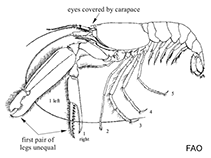Potamalpheops tyrymembe Soledade, Santos & Almeida, 2014
Google image | No image available for this species;
drawing shows typical species in Alpheidae.
Classification / Names Common names | Synonyms | CoL | ITIS | WoRMS
Malacostraca | Decapoda | Alpheidae
Environment: milieu / climate zone / depth range / distribution range Ecology
Benthic; brackish; depth range 1 - 3 m (Ref. 129123). Tropical
Distribution Countries | FAO areas | Ecosystems | Occurrences | Introductions
Southwest Atlantic: Brazil.
Length at first maturity / Size / Weight / Age
Maturity: Lm ? range ? - ? cm Max length : 0.4 cm CL male/unsexed; (Ref. 129123)
Short description Morphology
Life cycle and mating behavior Maturity | Reproduction | Spawning | Eggs | Fecundity | Larvae
Main reference
References | Coordinator | Collaborators
Soledade, G.O., P.S. Santos and A.O. Almeida 2014 Potamalpheops tyrymembe sp. n.: the first southwestern Atlantic species of the shrimp genus Potamalpheops Powell, 1979 (Caridea: Alpheidae). Zootaxa 3760(4): 579-586. (Ref. 129123)
IUCN Red List Status
(Ref. 130435: Version 2025-1)
CITES status (Ref. 108899)
CMS (Ref. 116361)
Threat to humans
Human uses
| FishSource |
Tools
More information
Diet composition
Food consumption
Predators
Max. ages / sizes
Length-weight rel.
Length-length rel.
Length-frequencies
Mass conversion
Abundance
Maturity
Fecundity
Spawning
Eggs
Egg development
Larvae
Internet sources
BHL | BOLD Systems | CISTI | DiscoverLife | FAO(Publication : search) | Fishipedia | GenBank (genome, nucleotide) | GloBI | Gomexsi | Google Books | Google Scholar | Google | PubMed | Tree of Life | Wikipedia (Go, Search) | Zoological Record



